Molluscs of Australia
| Anatomy of Molluscs |
Molluscs have a huge range of shapes and sizes even with a single group like the Gastropods. They, however, also have many features in common. This is what is examined in this section.
Shell
Many molluscs have shells. The edge of the mantle secretes a shell of calcium carbonate, chitin and conchiolin.
Chitin is a tough, semitransparent carbohydrate. The exoskeletons of insects are made from chitin.
Conchiolin is a complex protein which forms chambers which hold and bond to the crystals of calcium carbonate. |
|
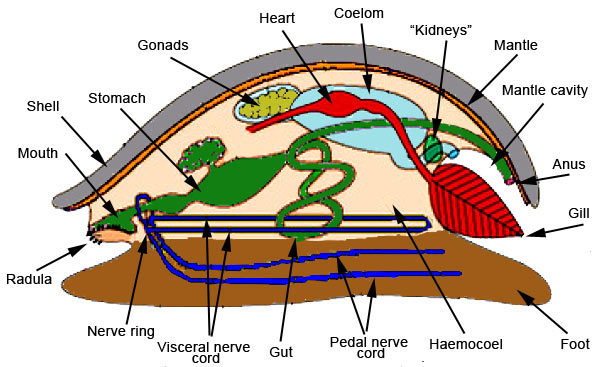
Anatomy of a "generalized mollusc" |
| |
|
Mantle and mantle cavity
Molluscs also have an extension of the body wall called the mantle. This fleshy tissue is responsible for secreting the shell. The mantle encloses the mantle cavity which contains the gills, anus and excretory pores.
Gills
Most molluscs have one pair or only one feather-shaped gill found in the mantle cavity. Water enters near the bottom and leaves near the top. The gill filaments have cilia (like tiny hairs) , one type of cilia beat to drive water through the mantle cavity, the other two types clean the gills. Each gill has an incoming blood vessel connected to the hemocoel and another leading to the heart. |
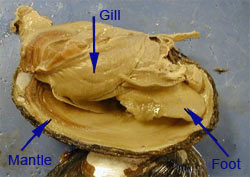
|
| |
|
Foot
The underside of most molluscs consists of a muscular foot, which has different purposes in different classes. For example,in gastropods the foot secretes mucuswhich acts as a lubricant to help movement; in many shells the foot acts as a sucker attaching the animal to a hard surface. In bivalves, the foot is used for burrowing into the sediment; in cephalopods it is used for jet propulsion, and the tentacles and arms are formed from the foot. |
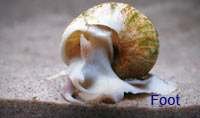
|
| |
|
Radula
Most molluscs have a muscular mouths with a radula ("tongues") lined with many rows of teeth made from chitin. The teeth are replaced from the rear as they wear out. The radula is used to scrape bacteria and algae off rocks in herbivorous gastropods or to bore holes into other animals’ shells or skeletons in carnivorous gastropods.
Mucus, formed in the mouth, mixes with the food and is pushed towards the stomach by cilia. Undigested materials are compressed and packaged, then released through the anus into the mantle cavity and are carried away from the animals in the water currents.
Coelom
The coelom is a fluid-filled cavity that develops within the body. It functions as a hydrostatic skeleton and provides a space in which the internal organs can be suspended. |
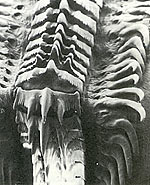
Highly magnified snail radula |
| |
|
A hydrostatic skeleton is a structure found in many cold-blooded organisms and soft-bodied animals consisting of a fluid-filled cavity, the coelom, surrounded by muscles. The pressure of the fluid and action of the surrounding muscles are used to change an organism's shape and produce movement, such as burrowing or swimming.
Haemocoel
A haemocoel is a series of spaces between the organs of organisms with open circulatory systems, like most arthropods and molluscs. Blood and other fluids circulate through the haemocoel. It encloses most of the internal organs.
In open circulatory systems (found in crustaceans, insects, molluscs and other invertebrates) the blood does not circulate entirely within vessels but is collected from the gills, pumped through the heart, and released directly into spaces (the haemocoel) in the tissues from which it returns to the gills and then to the heart. There are no capillaries to return blood to the heart.
Heart
The heart is an important part of the circulatory system, pumping blood into the haemocoel, as well as an important part the reproductive and excretory systems. |
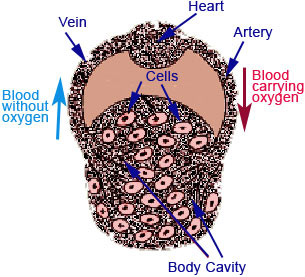
|
| |
|
Kidneys
Excretion is carried out by a pair of “kidneys” (nephridia), tubular structures that collect fluids from the coelom and exchange salts and other substances with body tissues as the fluid passes along the tubules for excretion. The kidneys empty into the mantle cavity. The heart and “kidneys” is an important part of the circulatory system as well as the reproductive and excretory systems. The "kidneys" are an important part of the excretory system as well as an important part the reproductive and circulatory systems.
Nervous System
Molluscs have two pairs of main nerves (three in bivalves) the visceral cords serving the internal organs and the pedal ones serving the foot. Only some species of molluscs have a brain.
Most molluscs have a head with eyes, and all have a pair of tentacles with sensors, also on the head, that detect chemicals, vibrations and touch. The eyes of the giant squid are the largest in the animal kingdom, almost the size of dinner plates.
Reproduction
The simplest molluscan reproductive system relies on external fertilization. Two gonads are located next to the coelom and release ova or sperm into it. The kidneys extract them from the coelom and release them into the mantle cavity from which they can reach the water or land. Some molluscs use internal fertilization and/or are hermaphrodites, functioning as both sexes; both of these methods require more complicated reproductive systems.
After fertilization, marine mollusc eggs grow into planktonic larvae which eat floating particles. Eventually the larva sinks to the seafloor and metamorphoses into the adult form.
Adapted from Wikipedia Molluscs http://en.wikipedia.org/wiki/Mollusca
Next: Aplacophora ...
|
|